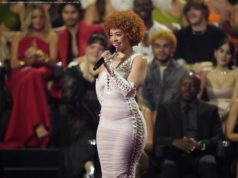Political art that outlasts its times needs more than just a powerful message.
A few months ago, the fearsome music critic Greil Marcus came across an old song he’d never heard before. Though the radio, against doo-wop harmonies and wandering guitar arpeggios, a woman crooned, “It isn’t nice to block the doorway / It isn’t nice to go to jail / There are nicer ways to do it, but the nice ways always fail.”
“The thing just sucked me in,” Marcus said Friday during a panel about protest and community at the Aspen Ideas Festival, which is cosponsored by The Atlantic and the Aspen Institute. “I found myself hearing and memorizing every word.”
So he called up the radio station and found out what song it was: “It Isn’t Nice,” released by Barbara Dane and the Chambers Brothers in 1966.
Marcus knew about the Chambers Brothers, a ’60s soul band. Only five years ago, Lester Chambers had dedicated a song in concert to Trayvon Martin—and was swiftly attacked by an angry woman in the audience. Marcus also knew about Barbara Dane. He’d remembered her from anti-war rallies at UC Berkeley, “when she would get up and sing these hortatory songs— you have to do this, you have to do that, this is right, and that is wrong —with almost no musical feeling in them” he recalled. “And here she is wailing like Dion in ‘Lovers Who Wander’ or something.”
The song’s lyrics, by Malvina Reynolds, obviously carry eerie relevance during a moment of national debate around “civility” versus civil disobedience: “It isn’t nice to dump the groceries / Or to sit in on the floor… But if that is freedom’s price / We don’t mind.” Yet Marcus wasn’t extolling the words, per se. He was extolling a feeling that still crackles 52 years after it was first captured. Many of Dane’s other songs—those “hortatory” ones—may not connect with listeners today. This one does.
Protest songs necessarily speak to their moment, embracing the “current” in “current events.” But Marcus’s example underscores how truly great works build a bridge not only between the concerns of their time and a longer historical struggle, but also between the performer’s feelings and the common well of human sentiment. The most consequential protest songs get referenced again and again for a reason: their power, both felt and understood, never dies.
Why doesn’t it? The hoariest example of the protest genre, “We Shall Overcome,” began as gospel, was repurposed for the civil-rights movement, and keeps finding new applications today. The song’s so durable in part because it lacks pointed references to time or place. “Sometimes, specificity isn’t the friend of a protest song as it ages,” the songwriter Joe Henry observed during the protest panel. “We don’t go back to ‘Who Killed Davey Moore,’” he said, referencing Bob Dylan’s 1963 critique of the brutality of boxing, “the way we go back to ‘The Times They Are A-Changin’.”
We also still go back to “The Revolution Will Not Be Televised,” Gil Scott-Heron’s manifesto that’s somehow both strident and sensual as it namechecks Richard Nixon, Spiro Agnew, and Natalie Wood. “It’s really powerful and not dated, even though he’s making all kinds of pointed cultural references that are locked to a particular time and place,” Henry said. Heron’s blistering performance is surely part of why. So is the way that performance comports with the larger message, in line with that of “It Isn’t Nice”: Progress isn’t pretty.
Not all protest songs are so overt. Rather, they rely on context, subtext, and emotion. African American spirituals, for example, were more than spiritual: they allowed a dehumanized people to “to sing themselves into being” and communicate in “code,” as the Yale professor Daphne Brooks put it. At Aspen, she queued up a recording of the 1800s standard “Steal Away,” whose simple lyrics contain multitudes of meaning about self-determination. Slow, velvety delivery of those lyrics by the Princely Players sent a chill across the hotel ballroom where the panel was taking place. The song is very much alive.
Other tunes become political only when delivered by certain performers. The critic Ann Powers pointed to Adam Lambert subverting the machismo of Led Zeppelin on American Idol, and Henry mentioned Sly and the Family Stone’s take on “Que Sera Sera,” a funky flip of gender and race. Brooks praised Beyoncé’s recent Coachella performance, whose staging and song choices turned her catalogue into a celebration of HBCUs and black achievement. “It was also about scope, and about scale, and about majesty,” Brooks said. “It was about, as the great Tony Kushner would say in Angels in America, more life.”
More-ness indeed might be an underrated factor in protest art, as heard when Marcus played the 2017 song “Cleveland” by the rock band Algiers. Through a surging storm of sound, the singer Franklin James Fisher cries out the names of black people who have died while in state custody. Marcus envisioned someone stumbling across the song “in 10 or 20 or a hundred years when all of the people whose names Fisher chants is forgotten,” and it striking them “as something absolutely new—just as the Barbara Dane song from 50-some years ago spoke to me as something absolutely new.” In Marcus’s telling, the song “creates a community of the dead, but it also creates a community of the future.” A community of the future —if a protest song lasts, it’s because it wills such a community into existence.






